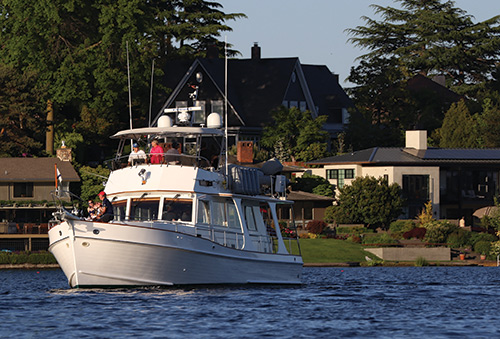 Words: Wendy Hinman
Words: Wendy Hinman
When people refer to a trawler, what comes to my mind are the lumbering steel fishing behemoths designed by once local MARCO shipyards, where my husband, Garth Wilcox, worked throughout the 1990s. Today, however, the term trawler is used to describe pleasure yachts that bear little resemblance to working steeds. I was curious to discover how this nomenclature came to be applied to such different vessels. Being married to a naval architect, I started asking questions. What I found was a hornet’s nest of subtleties and differing opinions.
The Workboats
Trawlers are a type of fishing boat that drags nets, usually over the sea floor, but sometimes through the mid-water column. Trawling, or dragging as it was also called, started with sail and evolved to steam-powered vessels in the UK and Scandinavia. Working trawlers found their ways across the Atlantic, where the large continental shelf provided ideal habitat for bottom fish. They reached the Pacific Northwest and Alaska in the 1920s. Initially, the trawlers were crafted of wood, then later of steel. More recently smaller vessels are made of fiberglass.
Regardless of the construction method, these workhorses needed to be strong and seaworthy to withstand the extreme forces of the ocean, with powerful engines capable of dragging nets through the water faster than fish can swim. This was a tall order, especially in the severe fogs and storms of the north Atlantic or the frozen wilds of Alaska’s Bering Sea. They were full displacement vessels that could move at moderate speeds with a low center of gravity that granted them good seakeeping characteristics in a broad range of conditions. Their deep, wide hull shape allowed for large fuel and water tankage, and a sizeable hold capacity for extended periods away from port. They tended to be single-screw hulls, with keel drag and a skeg that aided tracking in waves. A plumb bow maximized the load it could carry and a vessel’s useable waterline. High bulwarks kept them drier in stormy conditions. These vessels were known for being capable and dependable.
In the same way that modern kitchens have embraced industrial-style and brushed-stainless appliances, modern motor yacht design capitalizes on commercial vessels’ solid reputation for ruggedness, seaworthiness, and reliability. When looking for a solid boat design, it is natural to begin with ones that are proven.
Trawler Evolution
Early versions of pleasure motor yachts were often converted fishing boats or vessels that were designed and custom built expressly for recreational use during slack periods by companies who typically served the fishing industry. Traditionally, trawling was done over the side of the vessel on the main deck, forward of the pilothouse. Romsdal North Sea trawlers were a design closely related to the Scottish trawlers of the 1870s. Much later, stern trawlers were developed that placed the pilothouse forward. Pacific Northwest trawlers are universally stern trawlers with the pilothouse forward, which allows for various possible uses, including trolling, and many trawler yachts follow this styling.
MARCO’s Seattle Shipyard, known for building quality fishing vessels, built private yachts in the ‘50s and ‘60s. They were variously called yachts, diesel cruisers, or Alaska cruisers, but never trawlers. Still, they looked much like other Northwest yachts of the day, some of which came to be called trawlers. The difference was likely due to a more precise nomenclature on the part of a company invested in building real trawlers, trollers, seiners, tugs, and other workboats tasked with demanding duties. Naval architects who’ve designed fishing trawlers bristle at a comparison between the original trawlers and the trawler-yachts that have co-opted the name.
“A trawler is a fishing vessel [that] tows a net behind it. How can you call something like a Grand Banks a trawler when it has no rigging, winches, or deck space to trawl?” says an exasperated Chuck Cannon, who designed the real workhorses for many years at MARCO Shipyard.
Who actually deserves the credit or blame for creating the concept of recreational trawler is subject to debate.
Many naval architects adapted commercial-fishing boat designs for pleasure use. Among the most recognized for this were Art DeFever, Bill Garden, Ed Monk Sr., Hugh Angelman, and Kenneth Smith. In my research, these names kept popping up over and over, though in no way can I say it’s a comprehensive list.